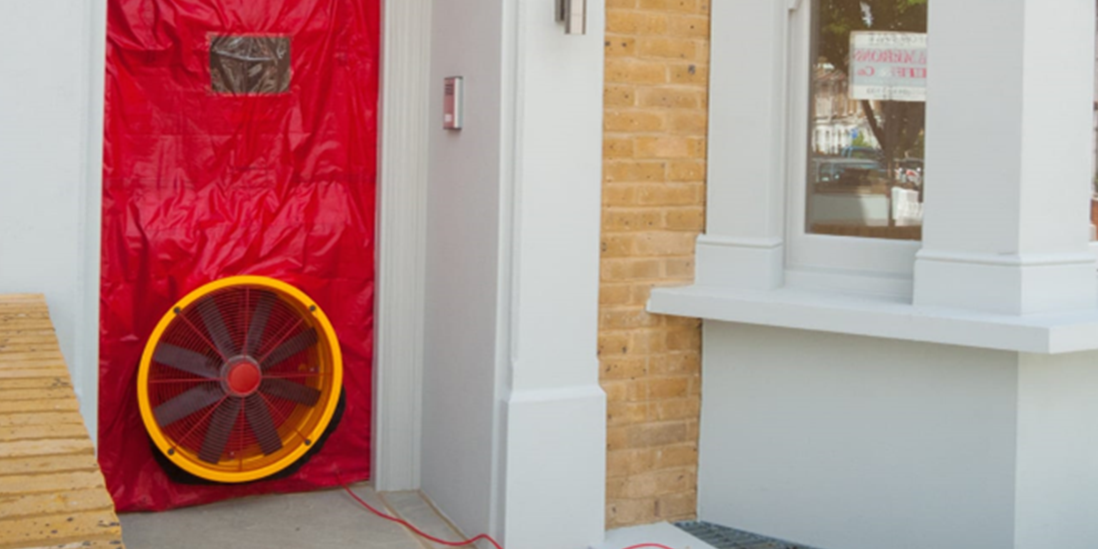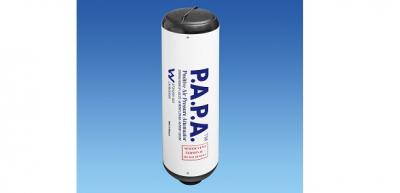How does air permeability testing affect your dwelling ventilation strategy?
Figure 1: Air permeability testing (courtesy of energy-test.co.uk)
Part L of the Building Regulations places limits on the minimum standards of air permeability and requires all new dwellings to have an air pressure test. However, achieving a highly airtight dwelling may affect your ventilation strategy needed to show compliance with Part F of the Building Regulations
Air pressure testing is used around the world as a method of determining air leakage in buildings. It was first introduced in Approved Document L of the Building Regulations in England and Wales in 2002. In 2006 it became mandatory in England and Wales to undertake air testing to a sample number of dwellings on a site.
However, by virtue of Regulation 43, the guidance in the current Approved Document L Volume 1 in England (2021 edition) and Wales (2022 edition) is that an air pressure test should be carried out on every new build dwelling. Approved Document L Volume 1 also sets out the minimum air permeability requirements for dwellings as follows:
- 8.0 m3/(h.m2) when pressure tested at 50 Pascals (Pa)
- 1.57 m3/(h.m2) when pressure tested at 4 Pascals (Pa)
Despite the minimum standards above set out in Approved Document L Volume 1, it is likely that significantly better air permeability will be required to ensure that the dwelling primary energy rate, dwelling emission rate and dwelling fabric energy efficiency complies with the wider requirements of Part L.
This is because air permeability can have a substantial impact on the overall energy performance of a new dwelling. For example, better air permeability will often result in a dwelling using less energy when compared to a similar property with worse air permeability. However, as air permeability improves, the property becomes more airtight – this means that the ventilation strategy for the dwelling needs to be appropriate to ensure that it still complies with Part F of the Building Regulations.
What is Approved Document F?
Approved Document F Volume 1 in England (2021 edition) and Wales (2022 edition) provides guidance on how new dwellings may comply with the functional requirements of Part F of the Building Regulations.
The aim of Part F is to protect the health of occupants of the dwelling by providing adequate ventilation. Without adequate ventilation, mould and internal air pollution might become hazardous to health. Broadly, the ventilation strategy of a new dwelling will be required to be sufficient to:
- extract water vapour and indoor air pollutants from areas where they are produced in significant quantities (e.g. kitchens, utility rooms and bathrooms) before they spread through the building
- supply a minimum level of outdoor air for occupants’ health
- rapidly dilute indoor air pollutants, and disperse water vapour when necessary, in habitable rooms
- minimise the entry of external air pollutants
- achieve all of the following, as far as is reasonably practicable:
- produce low levels of noise
- offer easy access for maintenance
- provide protection from cold draughts
Approved Document F Volume 1 provides guidance on a number of different ventilation systems that can be used to show compliance with the above, namely:
- natural ventilation
- continuous mechanical extract ventilation
- mechanical ventilation with heat recovery
We will now briefly explore what each of these different ventilation systems are…
What is natural ventilation?
Natural ventilation is generally considered to be ventilation provided by thermal, wind or diffusion effects through doors, windows, or other intentional openings without the use of mechanically driven equipment. Approved Document F Volume 1 provides guidance on how to provide natural ventilation by using a mix of purge ventilation, background ventilation and intermittent extract fans.
Purge ventilation provides manually controlled ventilation of rooms or spaces at a relatively high rate to rapidly dilute pollutants and/or disperse water vapour. Purge ventilation in a dwelling is typically provided by opening external doors and/or windows. Whereas background ventilation provides low level ventilation throughout the dwelling and is typically provided by way of installing trickle vents at the head of external doors and windows.
Intermittent extract fans are mechanical ventilators that do not run all the time, usually running only when there is a particular need to remove pollutants or water vapour (such as during cooking or bathing). Intermittent operation may be under either manual or automatic control.
Historically, natural ventilation has been the most popular method for designers and builders to use to demonstrate compliance with Part F of the Building Regulations. It is also the method that is most familiar to occupants of dwellings in the UK.
What is continuous mechanical extract ventilation?
Continuous mechanical extract ventilation is generally defined as mechanically driven ventilation that continuously extracts indoor air and discharges it to the outside. Continuous mechanical extract ventilation systems may consist of one of the following:
- a central extract system
- individual room extract fans
- a combination of a central extract system and individual room extract fans
Background ventilation may still be needed where continuous mechanical extract ventilation is installed, albeit this is typically limited to habitable rooms only.
What is mechanical ventilation with heat recovery?
Mechanical ventilation with heat recovery is generally defined as a mechanically driven ventilation system that both continuously supplies outdoor air to the inside of the dwelling and continuously extracts indoor air and discharges it to the outside.
To avoid unintended air pathways, background ventilation is not required to be installed with mechanical ventilation with heat recovery – this is because the efficiency of the system improves as the dwelling becomes more airtight.
How does air permeability affect the choice of ventilation system for a new dwelling?
Approved Document F Volume 1 states that natural ventilation is not suitable for highly airtight dwellings. Whereas continuous mechanical extract ventilation or mechanical ventilation with heat recovery can be used in any dwelling.
Highly airtight dwellings are dwellings which have one of the following:
- a ‘design’ air permeability lower than 5m3/(h·m2) at 50Pa
- an ‘as-built’ air permeability lower than 3m3/(h·m2) at 50Pa
At design stage it is straight forward to select the most suitable ventilation system that is compatible with the assumed ‘design’ air permeability rate – namely, for the purposes of compliance with Part F, where the ‘design’ air permeability is assumed to be lower than 5m3/(h·m2) at 50P, the dwelling is classified as highly airtight. The choice of ventilation system is limited to either continuous mechanical extract ventilation or mechanical ventilation with heat recovery.
However, compliance with Part F becomes slightly trickier when a dwelling is designed to have natural ventilation, but upon being built is pressure tested which determines that the dwelling is highly airtight by virtue of having an air permeability lower than 3m3/(h·m2) at 50Pa. In this situation, the designer and/or builder has one of the following options:
a) seek expert advice to assess how the ‘as-built’ dwelling complies with Part F, or
b) install a continuous mechanical extract ventilation system
To avoid attempting to retrofit a centralised continuous mechanical extract ventilation system, it may be possible to consider a decentralised option.
This is a technical area of the regulations and the information contained in this article is only an introductory guide to the subject matter, therefore competent persons should always be used to design and construct dwellings to ensure compliance with Part F and L of the Building Regulations.
Please Note: Every care was taken to ensure the information was correct at the time of publication. Any written guidance provided does not replace the user’s professional judgement. It is the responsibility of the dutyholder or person carrying out the work to ensure compliance with relevant building regulations or applicable technical standards.
Sign up to the building bulletin newsletter
Over 48,000 construction professionals have already signed up for the LABC Building Bulletin.
Join them and receive useful tips, practical technical information and industry news by email once every 6 weeks.
Subscribe to the Building Bulletin




Comments
Your descriptive terms of air permeability are misleading..
Submitted 1 year 7 months ago
Add new comment